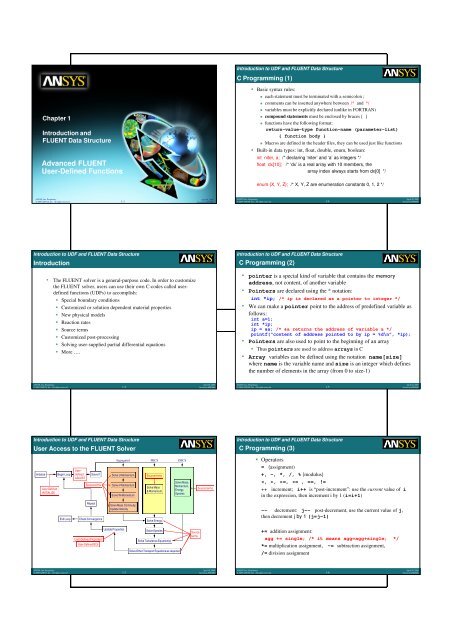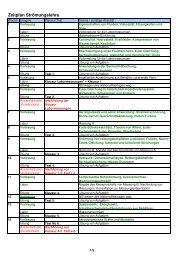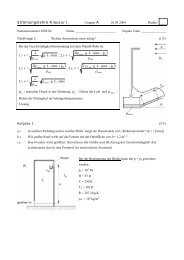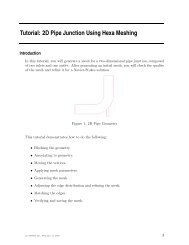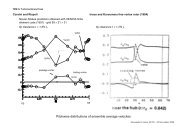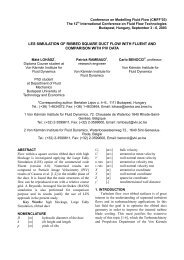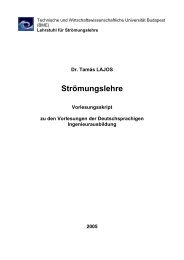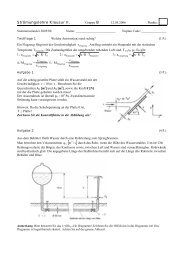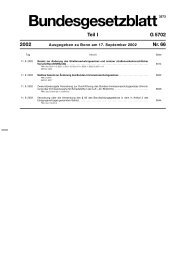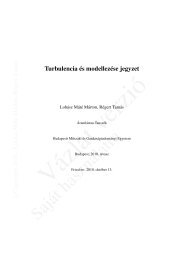Advanced FLUENT User-Defined Functions
Advanced FLUENT User-Defined Functions
Advanced FLUENT User-Defined Functions
Create successful ePaper yourself
Turn your PDF publications into a flip-book with our unique Google optimized e-Paper software.
Chapter 1<br />
Introduction and<br />
<strong>FLUENT</strong> Data Structure<br />
<strong>Advanced</strong> <strong>FLUENT</strong><br />
<strong>User</strong>-<strong>Defined</strong> <strong>Functions</strong><br />
ANSYS, Inc. Proprietary<br />
April 30, 2009<br />
© Fluent Inc. 11/16/2010<br />
© 2006 © 2009 ANSYS, ANSYS, Inc. Inc. All All rights rights reserved.<br />
1-1<br />
ANSYS, Inventory Inc. Proprietary #002686<br />
Introduction to UDF and <strong>FLUENT</strong> Data Structure<br />
Introduction<br />
• The <strong>FLUENT</strong> solver is a general-purpose code. In order to customize<br />
the <strong>FLUENT</strong> solver, users can use their own C-codes called userdefined<br />
functions (UDFs) to accomplish:<br />
� Special boundary conditions<br />
� Customized or solution dependent material properties<br />
� New physical models<br />
� Reaction rates<br />
� Source terms<br />
� Customized post-processing<br />
� Solving user-supplied partial differential equations<br />
� More ….<br />
ANSYS, Inc. Proprietary<br />
© 2009 ANSYS, Inc. All rights reserved. 1-2<br />
Introduction to UDF and <strong>FLUENT</strong> Data Structure<br />
<strong>User</strong> Access to the <strong>FLUENT</strong> Solver<br />
Initialize Begin Loop<br />
<strong>User</strong> <strong>Defined</strong><br />
INITIALIZE<br />
Exit Loop<br />
<strong>User</strong>defined<br />
ADJUST<br />
Repeat<br />
Solver?<br />
Source terms<br />
Check Convergence<br />
<strong>User</strong>-<strong>Defined</strong> Properties<br />
<strong>User</strong>-<strong>Defined</strong> BCs<br />
Update Properties<br />
ANSYS, Inc. Proprietary<br />
© 2009 ANSYS, Inc. All rights reserved. 1-3<br />
Segregated PBCS<br />
Solve U-Momentum<br />
Solve V-Momentum<br />
Solve W-Momentum<br />
Solve Mass Continuity;<br />
Update Velocity<br />
Source terms<br />
Solve Mass<br />
& Momentum<br />
Solve Energy<br />
Solve Species<br />
Solve Turbulence Equation(s)<br />
Solve Other Transport Equations as required<br />
DBCS<br />
Solve Mass,<br />
Momentum,<br />
Energy,<br />
Species<br />
Source<br />
terms<br />
April 30, 2009<br />
Inventory #002686<br />
Source terms<br />
April 30, 2009<br />
Inventory #002686<br />
Introduction to UDF and <strong>FLUENT</strong> Data Structure<br />
C Programming (1)<br />
� Basic syntax rules:<br />
� each statement must be terminated with a semicolon ;<br />
� comments can be inserted anywhere between /* and */<br />
� variables must be explicitly declared (unlike in FORTRAN)<br />
� compound statements must be enclosed by braces { }<br />
� functions have the following format:<br />
return-value-type function-name (parameter-list)<br />
{ function body }<br />
� Macros are defined in the header files, they can be used just like functions<br />
� Built-in data types: int, float, double, enum, boolean:<br />
int niter, a; /* declaring ‘niter’ and ‘a’ as integers */<br />
float dx[10]; /* ‘dx’ is a real array with 10 members, the<br />
array index always starts from dx[0] */<br />
enum {X, Y, Z}; /* X, Y, Z are enumeration constants 0, 1, 2 */<br />
ANSYS, Inc. Proprietary<br />
© 2009 ANSYS, Inc. All rights reserved. 1-4<br />
Introduction to UDF and <strong>FLUENT</strong> Data Structure<br />
C Programming (2)<br />
ANSYS, Inc. Proprietary<br />
© 2009 ANSYS, Inc. All rights reserved. 1-5<br />
April 30, 2009<br />
Inventory #002686<br />
• pointer is a special kind of variable that contains the memory<br />
address, not content, of another variable<br />
• Pointers are declared using the * notation:<br />
int *ip; /* ip is declared as a pointer to integer */<br />
• We can make a pointer point to the address of predefined variable as<br />
follows:<br />
int a=1;<br />
int *ip;<br />
ip = &a; /* &a returns the address of variable a */<br />
printf(“content of address pointed to by ip = %d\n”, *ip);<br />
• Pointers are also used to point to the beginning of an array<br />
� Thus pointers are used to address arrays in C<br />
• Array variables can be defined using the notation name[size]<br />
where name is the variable name and size is an integer which defines<br />
the number of elements in the array (from 0 to size-1)<br />
Introduction to UDF and <strong>FLUENT</strong> Data Structure<br />
C Programming (3)<br />
� Operators<br />
= (assignment)<br />
+, -, *, /, % (modulus)<br />
, >=,
Introduction to UDF and <strong>FLUENT</strong> Data Structure<br />
C Programming (4)<br />
� Basic control structures<br />
if ( … )<br />
;<br />
if ( …)<br />
;<br />
else<br />
;<br />
if ( …)<br />
;<br />
else if ( … )<br />
;<br />
ANSYS, Inc. Proprietary<br />
© 2009 ANSYS, Inc. All rights reserved. 1-7<br />
For Loops:<br />
for ( k=0; k < NUM; k++ )<br />
;<br />
While Loops:<br />
Introduction to UDF and <strong>FLUENT</strong> Data Structure<br />
CFD Programming in <strong>FLUENT</strong><br />
while ( … )<br />
;<br />
Conditional Operator (? : )<br />
( condition ? operand a : operand b )<br />
example:<br />
false<br />
real At = (rp_axi ? At*2*M_PI : At );<br />
• We (as CFD programmers in <strong>FLUENT</strong>) want to know how <strong>FLUENT</strong><br />
organizes data so that we know:<br />
� How to access mesh information for a particular cell zone or a face zone<br />
� Cell centroids, cell volumes, the neighbors, etc.<br />
� Face centroids, face areas, face normal directions (vectors), etc.<br />
� How to access field data for cells (and faces): pressure, velocity, density, etc.<br />
� How to efficiently loop through these cells or faces in the codes<br />
• How to supply customized source terms, boundary conditions, and fluid<br />
properties, etc., to the solver<br />
• How to modify the behaviors or specific model parameters for various<br />
physical models as in turbulence, reactions kinetics, multiphase, and<br />
dynamic mesh, etc.<br />
• How to implement user’s own governing equations in the finite-volume<br />
framework of <strong>FLUENT</strong> solver<br />
ANSYS, Inc. Proprietary<br />
© 2009 ANSYS, Inc. All rights reserved. 1-8<br />
Introduction to UDF and <strong>FLUENT</strong> Data Structure<br />
Data Structure Overview<br />
Cell<br />
cell<br />
face<br />
ANSYS, Inc. Proprietary<br />
© 2009 ANSYS, Inc. All rights reserved. 1-9<br />
cell<br />
Domain<br />
true<br />
Domain<br />
Thread<br />
Cell<br />
Boundary (face thread or zone) Fluid (cell thread or zone)<br />
April 30, 2009<br />
Inventory #002686<br />
April 30, 2009<br />
Inventory #002686<br />
April 30, 2009<br />
Inventory #002686<br />
Introduction to UDF and <strong>FLUENT</strong> Data Structure<br />
The Domain<br />
• Domain is the set of connectivity and hierarchy info for the entire<br />
data structure in a given problem for single phase flows. It includes:<br />
� all fluid zones (‘fluid threads’)<br />
� all solid zones (‘solid threads’)<br />
� all boundary zones (‘boundary threads’)<br />
• Cell: Cell is the computational unit, conservation equations are<br />
solved over each cell<br />
• Face: direction is in the outward normal<br />
• Threads: represent the collection of cells or faces; a Thread<br />
represents a fluid or solid or boundary zone<br />
• multiphase simulations (singlephase simulations use single domain<br />
only)<br />
� Each phase has its own “Domain-structure”<br />
� Geometric and common property information are shared among ‘subdomains’<br />
� Multiphase UDF will be discussed later<br />
ANSYS, Inc. Proprietary<br />
© 2009 ANSYS, Inc. All rights reserved. 1-10<br />
Introduction to UDF and <strong>FLUENT</strong> Data Structure<br />
The Threads<br />
• A Thread is a sub-set of the Domain structure<br />
• Individual ‘fluid’, ‘solid’ and each ‘boundary’ zones are<br />
identified as ‘zones’ and their datatype is Thread<br />
• ‘Zone’ and ‘Thread’ terms are often used interchangeably<br />
• Some further details about Zone/Thread ID and Threaddatatype:<br />
� Zones are identified at mesh level with an integer ID in the<br />
Define/Boundary Condition panel<br />
� Threads, a Fluent-specific datatype, store structured information<br />
about the mesh, connectivity, models, property, etc. all in one place<br />
� <strong>User</strong>s identify zones through the ID’s<br />
� Zone/Thread-ID and Threads are correlated through UDF<br />
macro’s<br />
ANSYS, Inc. Proprietary<br />
© 2009 ANSYS, Inc. All rights reserved. 1-11<br />
Introduction to UDF and <strong>FLUENT</strong> Data Structure<br />
Cell and Face Datatypes<br />
• Control volumes of fluid and solid zones are also called ‘cells’ in<br />
<strong>FLUENT</strong><br />
� The data structure for the cell zones is typed as ‘cell_t’ (the cell<br />
thread index)<br />
� The data structure for the cell faces is typed as ‘face_t’ (the face<br />
thread index)<br />
• A fluid or solid zone is called a cell zone, which can be accessed by<br />
using cell threads<br />
• Boundary or internal faces can be accessed by using face threads<br />
ANSYS, Inc. Proprietary<br />
© 2009 ANSYS, Inc. All rights reserved. 1-12<br />
April 30, 2009<br />
Inventory #002686<br />
April 30, 2009<br />
Inventory #002686<br />
April 30, 2009<br />
Inventory #002686
Introduction to UDF and <strong>FLUENT</strong> Data Structure<br />
Some additional info on Faces<br />
• Each Control volume has a finite number of faces<br />
� Faces on the boundary are also typed ‘face_t’; their<br />
ensemble are listed as boundary face-threads with the<br />
fluid & solid cell-threads under Define-<br />
Boundary_Condition panel<br />
� Those faces which are inside the flow-domain and do not<br />
share any external boundary are not accessible from GUI<br />
(because you do not need them)<br />
� They can still be accessed from <strong>User</strong>-<strong>Defined</strong>-<strong>Functions</strong><br />
ANSYS, Inc. Proprietary<br />
© 2009 ANSYS, Inc. All rights reserved. 1-13<br />
Introduction to UDF and <strong>FLUENT</strong> Data Structure<br />
Fluent UDF Data Structure Summary<br />
� The data structure for accessing a cell zone is typed as ‘cell_t’<br />
(the cell thread index); the data structure for faces is typed as<br />
‘face_t’ (the face thread index)<br />
Type Example Declaration<br />
Domain *d d is a pointer to domain thread<br />
Thread *t t is a pointer to thread<br />
cell_t c c is cell thread index<br />
face_t f f is a face thread index<br />
Node *node node is pointer to a node<br />
ANSYS, Inc. Proprietary<br />
© 2009 ANSYS, Inc. All rights reserved. 1-14<br />
April 30, 2009<br />
Inventory #002686<br />
Boundary face-thread<br />
Fluid cell-thread<br />
the boundary-face ensemble<br />
the Control-volume<br />
ensemble Internal face-thread<br />
the Internal-face ensemble<br />
associated to cell-threads<br />
Nodes<br />
Introduction to UDF and <strong>FLUENT</strong> Data Structure<br />
Fluent UDF Data Structure Summary (2)<br />
• Each thread (zone) has a unique integer ID<br />
available in the boundary condition panel (or can<br />
be listed by the list-zone TUI command:<br />
/grid/modify-zones/list-zones)<br />
• Given a correct ID, the Lookup_Thread macro<br />
can retrieve the thread pointer<br />
int ID=7;<br />
Thread *tf=Lookup_Thread(domain, ID);<br />
• Conversely, given a thread pointer tf, the zone ID<br />
can be retrieved<br />
ID=THREAD_ID(tf);<br />
• Once we have the correct pointer (for a specific<br />
zone), we can access the members belonging to<br />
the zone without any problem. Thread pointer<br />
provides the leading address of the thread (zone)<br />
ANSYS, Inc. Proprietary<br />
© 2009 ANSYS, Inc. All rights reserved. 1-15<br />
April 30, 2009<br />
Inventory #002686<br />
April 30, 2009<br />
Inventory #002686<br />
Introduction to UDF and <strong>FLUENT</strong> Data Structure<br />
Geometry Macros<br />
• C_NNODES(c, t) Number of nodes in a cell<br />
• C_NFACES(c, t) No. of faces in a cell<br />
• F_NNODES(f, t) No. of nodes in a face<br />
• C_CENTROID(x, c, t) x, y, z-coords of cell centroid<br />
• F_CENTROID(x, f, t) x, y, z-coords of face centroid<br />
• F_AREA(A, f, t) Area vector of a face;<br />
• NV_MAG(A) Area-magnitude<br />
• C_VOLUME(c, t) Volume of a cell<br />
• C_VOLUME_2D(c, t) Volume of a 2D cell<br />
C_NNODES(c,t) = 8<br />
(Depth is 1m in 2D; 2*π m in axi-symmetric solver C_NFACES(c,t) ) = 6<br />
• NODE_X(nn) Node x-coord; (nn is a node pointer)<br />
F_NNODES(f,t) = 4 each<br />
• NODE_Y(nn) Node x-coord;<br />
• NODE_Z(nn) Node x-coord;<br />
Many more are available. See the <strong>FLUENT</strong> UDF Manual<br />
ANSYS, Inc. Proprietary<br />
© 2009 ANSYS, Inc. All rights reserved. 1-16<br />
Introduction to UDF and <strong>FLUENT</strong> Data Structure<br />
Macros for Cell Variables<br />
• C_R(c,t) Density<br />
• C_P(c,t) Pressure<br />
• C_U(c,t)<br />
• C_V(c,t) Velocity components<br />
• C_W(c,t)<br />
• C_T(c,t) Temperature<br />
• C_H(c,t) Enthalpy<br />
• C_K(c,t) Turbulent kinetic energy<br />
• C_D(c,t) Turbulent energy dissipation<br />
• C_YI(c,t,i) Species mass fraction<br />
• C_UDSI(c,t,i) <strong>User</strong> defined scalar<br />
ANSYS, Inc. Proprietary<br />
© 2009 ANSYS, Inc. All rights reserved. 1-17<br />
Faces<br />
Nodes<br />
A Hex cell<br />
Location of cell variables<br />
C_CENTROID(X,c,t); X: X[3]<br />
t is a cell-thread pointer, c is a cell thread index, i is an integer<br />
for indexing<br />
Introduction to UDF and <strong>FLUENT</strong> Data Structure<br />
Macros for Cell Variables (2)<br />
• More cell variables<br />
• C_DUDX(c,t)<br />
• C_DUDY(c,t)<br />
• C_DUDZ(c,t)<br />
• C_DVDX(c,t)<br />
• C_DVDY(c,t) Velocity derivatives<br />
• C_DVDZ(c,t)<br />
• C_DWDX(c,t)<br />
• C_DWDY(c,t)<br />
• C_DWDZ(c,t)<br />
• C_MU_L(c,t) Laminar viscosity<br />
• C_MU_T(c,t) Turbulent viscosity<br />
• C_MU_EFF(c,t)<br />
• C_DP(c,t)[i] Pressure derivatives<br />
• C_D_DENSITY(c,t)[i] Density derivatives<br />
ANSYS, Inc. Proprietary<br />
© 2009 ANSYS, Inc. All rights reserved. 1-18<br />
April 30, 2009<br />
Inventory #002686<br />
April 30, 2009<br />
Inventory #002686<br />
April 30, 2009<br />
Inventory #002686
Introduction to UDF and <strong>FLUENT</strong> Data Structure<br />
Loop Macros in UDF<br />
� thread_loop_c(ct,d) { } for loop over cell threads in domain d<br />
� thread_loop_f(ft,d) { } for loop over face threads in domain d<br />
(Note: ct, ft and d are pointers to Thread)<br />
� begin_c_loop(c, t)<br />
{…}<br />
end_c_loop (c,t) for loop over cells in a given cell thread t<br />
� begin_f_loop(f, f_thread)<br />
{ … }<br />
end_f_loop(f, f_thread) for loop over all faces in a given<br />
face thread f_thread<br />
ANSYS, Inc. Proprietary<br />
© 2009 ANSYS, Inc. All rights reserved. 1-19<br />
Introduction to UDF and <strong>FLUENT</strong> Data Structure<br />
Macros for Accessing Cells/Faces<br />
• For any given face, the cell from which the<br />
face normal vector points away is called the C0<br />
cell; and the cell which the face normal vector<br />
points at is called the C1 cell. The following<br />
program fragment calculate the total cell<br />
volume next to a given face zone with zone ID<br />
on the C0 side:<br />
Thread *tf, *t0;<br />
face_t f;<br />
cell_t c0;<br />
real totalV=0.;<br />
tf = Lookup_Thread(domain, ID);<br />
t0 = THREAD_T0(tf);<br />
begin_f_loop(f, tf)<br />
{ c0=F_C0(f, tf); /*get the c0 thread */<br />
totalV += C_VOLUME(c0, t0);<br />
}<br />
end_f_loop(f, tf)<br />
ANSYS, Inc. Proprietary<br />
© 2009 ANSYS, Inc. All rights reserved. 1-20<br />
Introduction to UDF and <strong>FLUENT</strong> Data Structure<br />
Top-Level UDF Macros<br />
ANSYS, Inc. Proprietary<br />
© 2009 ANSYS, Inc. All rights reserved. 1-21<br />
C0<br />
C1<br />
April 30, 2009<br />
Inventory #002686<br />
a face normal<br />
vector for the C0 cell<br />
• <strong>User</strong>’s own codes must use the top-level UDF macros in order to<br />
communicate with the <strong>FLUENT</strong> solver<br />
� Profiles : DEFINE_PROFILE<br />
� Source terms : DEFINE_SOURCE<br />
� Properties : DEFINE_PROPERTY<br />
� <strong>User</strong>-defined Scalars : DEFINE_UNSTEADY<br />
DEFINE_FLUX<br />
DEFINE_DIFFUSIVITY<br />
� Initialization : DEFINE_INIT<br />
� Global <strong>Functions</strong> : DEFINE_ADJUST<br />
DEFINE_ON_DEMAND<br />
DEFINE_RW_FILE<br />
� Wall-heat-flux : DEFINE_HEAT_FLUX<br />
� Model-Specific <strong>Functions</strong> : DEFINE_DPM_…<br />
DEFINE_SR_RATE<br />
DEFINE_VR_RATE<br />
…<br />
Refer to the UDF Manual for a complete list<br />
April 30, 2009<br />
Inventory #002686<br />
April 30, 2009<br />
Inventory #002686<br />
Introduction to UDF and <strong>FLUENT</strong> Data Structure<br />
The Header Files<br />
� The udf-macros are defined in the ‘udf.h’ file<br />
� udf.h is a fluent header file in the {Fluent installed<br />
directory}/Fluent12.y/src/ directory<br />
� udf.h must be included at the top in each and every udf file<br />
� A file may contain more than one UDF<br />
� <strong>User</strong> can use multiple files for UDF<br />
� Any UDF you might write must use one of the ‘DEFINE_…’ macros from<br />
thisudf.h file<br />
� There are many more header files stored in the same directory can be<br />
browsed by users<br />
#define DEFINE_PROFILE(name, t, i) void name(Thread *t, int i)<br />
#define DEFINE_PROPERTY(name,c,t) real name(cell_t c, Thread *t)<br />
#define DEFINE_SOURCE(name, c, t, dS, i) \<br />
real name(cell_t c, Thread *t, real dS[], int i)<br />
#define DEFINE_INIT(name, domain) void name(Domain *domain)<br />
#define DEFINE_ADJUST(name, domain) void name(Domain *domain)<br />
#define DEFINE_DIFFUSIVITY(name, c, t, i) \<br />
real name(cell_t c, Thread *t, int i)<br />
ANSYS, Inc. Proprietary<br />
© 2009 ANSYS, Inc. All rights reserved. 1-22<br />
April 30, 2009<br />
Inventory #002686


